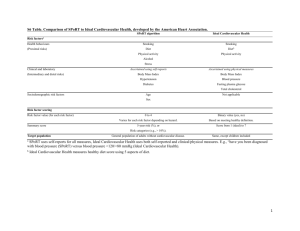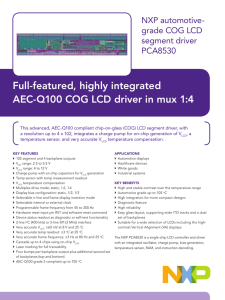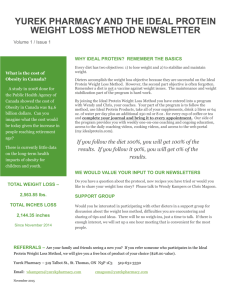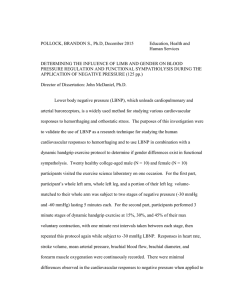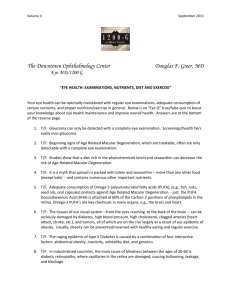ABSTRACT THESIS: STUDENT: DEGREE:
advertisement
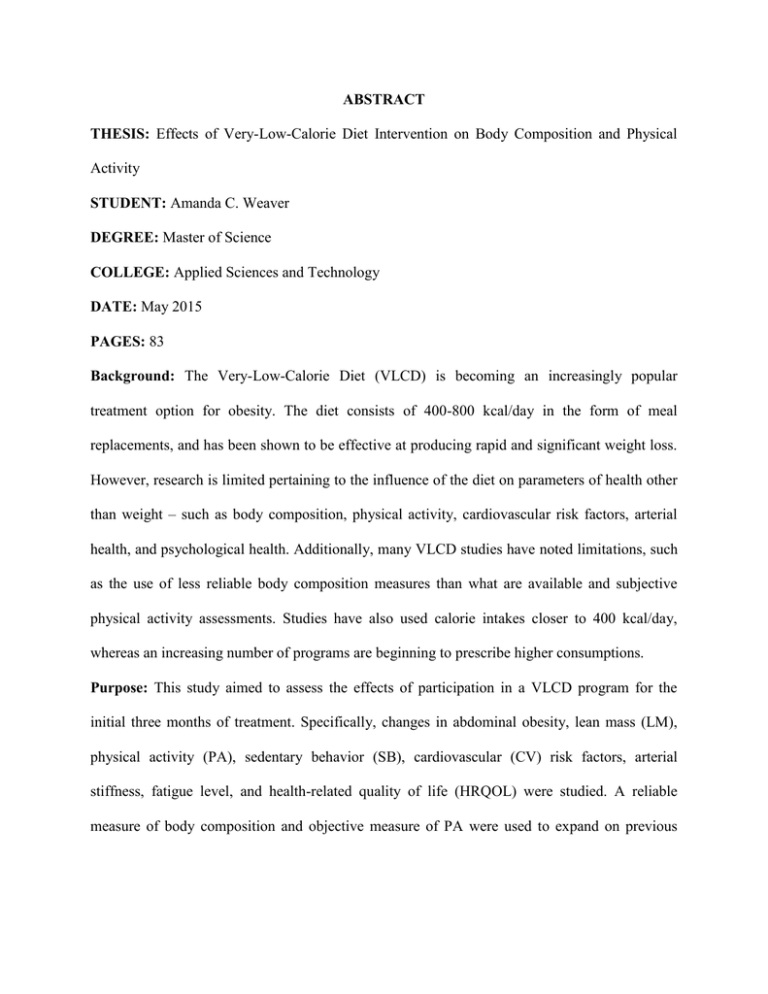
ABSTRACT THESIS: Effects of Very-Low-Calorie Diet Intervention on Body Composition and Physical Activity STUDENT: Amanda C. Weaver DEGREE: Master of Science COLLEGE: Applied Sciences and Technology DATE: May 2015 PAGES: 83 Background: The Very-Low-Calorie Diet (VLCD) is becoming an increasingly popular treatment option for obesity. The diet consists of 400-800 kcal/day in the form of meal replacements, and has been shown to be effective at producing rapid and significant weight loss. However, research is limited pertaining to the influence of the diet on parameters of health other than weight – such as body composition, physical activity, cardiovascular risk factors, arterial health, and psychological health. Additionally, many VLCD studies have noted limitations, such as the use of less reliable body composition measures than what are available and subjective physical activity assessments. Studies have also used calorie intakes closer to 400 kcal/day, whereas an increasing number of programs are beginning to prescribe higher consumptions. Purpose: This study aimed to assess the effects of participation in a VLCD program for the initial three months of treatment. Specifically, changes in abdominal obesity, lean mass (LM), physical activity (PA), sedentary behavior (SB), cardiovascular (CV) risk factors, arterial stiffness, fatigue level, and health-related quality of life (HRQOL) were studied. A reliable measure of body composition and objective measure of PA were used to expand on previous research. Findings from this study provide information to health care professionals regarding use of a VLCD as a weight loss treatment for overall health. Methods: Eighteen subjects (1 male) completed four visits for this study. The first visit consisted of completion of questionnaires including health-history, fatigue, and HRQOL. Subjects were asked to complete one week of objective PA monitor wear-time. The second visit followed the first by approximately one week. Measurements of body composition and arterial stiffness were obtained. The third and fourth visits were separated from the first and second by approximately three months and included a complete assessment of the same measures as the initial visits. Changes in initial to follow-up measures were assessed via paired-samples t-tests. Results: Significant improvements were found in initial to three-month follow up measures in weight (115.7 ± 31.2 kg to 101.0 ± 26.7 kg), abdominal fat (5.7 ± 2.4 kg to 4.3 ± 2.0 kg), systolic blood pressure (BP; 127 ± 16 mmHg to 112 ± 20 mmHg), diastolic BP (83 ± 9 mmHg to 69 ± 9 mmHg), fatigue severity (score 32 ± 11 to score 26 ± 10), and HRQOL (score 99 ± 11 to score 109 ± 9). Additionally, a significant decrease was detected in LM (51.8 ± 9.7 kg to 50.4 ± 9.1 kg). No significant changes were found in objective PA, objective SB, or arterial stiffness. Conclusions: The results of this study indicated weight loss via a VLCD consisting of 760 kcal/day was effective at producing positive changes in several measures of body composition and psychological health, and cardiovascular risk; and also resulted in a significant decrease in LM. Findings expanded on previous research to include a reliable measure of body composition that showed similar directional changes. Conversely, objective measurement of PA in the current study found no significant changes, whereas previous research using subjective measures has found increased PA engagement. Due to the relationship between PA and long-term weight loss maintenance, health care professionals should consider implementation of a specific exercise prescription as an integral component of a VLCD program. Key Words: obesity, very low calorie diet, body composition, physical activity, pulse wave velocity, cardiovascular risk, mental health
